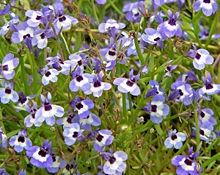
Downingia bella, also known as Hoover's calicoflower or Hoover's Downingia, is a member of the Bellflower Family (Campanulaceae). The genus is named after A.J. Downing (1815–1852) a noted American horticulturist and landscape architect.

Downingia is a genus of 13 annual plants native to western North America and Chile. Commonly known as calico flowers, they are notable for forming mass displays of small but colorful blooms around vernal pools. A number are uncommon endemics in California.
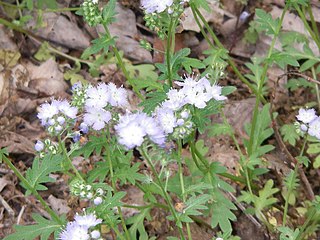
Phacelia purshii, known by the common names Miami mist, scorpionweed, and purple scorpionweed, is a spring flowering annual forb with blue, lavender, violet, or nearly white flowers in the Boraginaceae (borage) family that is native to eastern and central North America.

Orobanche uniflora, commonly known as one-flowered broomrape, one-flowered cancer root, ghost pipe or naked broomrape, is an annual parasitic herbaceous plant. It is native to much of North America, where it is a parasitic plant, tapping nutrients from many other species of plants, including those in the families Asteraceae and Saxifragaceae and in the genus Sedum. The name "orobanche" can be translated to "vetch-strangler" and "uniflora" can be translated to "single-flower".

Downingia bacigalupii is a species of flowering plant in the bellflower family (Campanulaceae) known by the common name Bach's calicoflower or Bacigalupi's downingia. This showy wildflower is native to the western United States from California to Idaho, where it is a resident of moist meadows and vernal pool ecosystems. This annual grows on a branching erect stem with small diamond-shaped leaves at intervals. At the top of each stem branch is one or more flowers, each between one and two centimeters wide. The flower has two long upper lobes which may be flat and straight or curl back, and are usually dark-veined blue. The three lower lobes are fused into one three-toothed surface, which is dark-veined blue with two bright yellow blotches rimmed with white in the center. The fruit is a dehiscent capsule two to five centimeters long. The stamens are fused together into an erect purple stalk bearing the dark anthers.
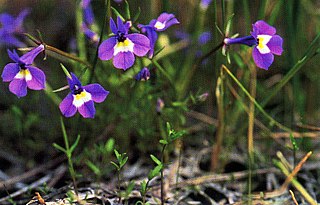
Downingia bicornuta is a species of flowering plant in the bellflower family known by the common name doublehorn calicoflower and double-horned downingia. This showy wildflower is native to the western United States from California to Idaho, where it is a resident of lakesides and vernal pool ecosystems.
Downingia cuspidata is a species of flowering plant in the bellflower family known by the common name toothed calicoflower. This showy wildflower is native to California, where it is a resident of ponds, meadows, and vernal pool ecosystems throughout the state. Its range may extend into Mexico.
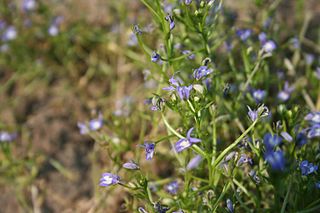
Downingia elegans is a species of flowering plants in the bellflower family known by the common names elegant calicoflower and Californian lobelia. This showy wildflower is native to western North America from California to British Columbia, where it is a resident of meadows and vernal pool ecosystems. This annual grows on a branching erect stem with many pointed leaves. At the top of each stem branch is one or more flowers, each one half to two centimeters wide. The tubular flower has two long, narrow, pointed upper lobes which are generally rich purple. The lower lip is fused into one three-lobed surface, which is purple with a large blotch of white in the center. The lobes may be quite pointed. There is sometimes some yellow coloration near the mouth of the tube.
Downingia insignis is a species of flowering plant in the bellflower family known by the common names harlequin calicoflower and cupped downingia. This showy wildflower is native to the western United States from California to Idaho, where it is a resident of lakesides and vernal pool ecosystems.

Downingia laeta is a species of flowering plant in the bellflower family known by the common name Great Basin calicoflower. This showy wildflower is native to western North America from California to Saskatchewan, where it is a resident of riverbanks, ponds, and vernal pool ecosystems. This annual grows on a thick erect stem with a few short, pointed leaves. Atop the stem is usually a single flower, which has an upper lip made up of two narrow, pointed lobes in shades of very light blue or purple, or white, and a lower lip which is a fusion of three lobes in the same color with two bright yellow spots and sometimes some purple or pink blotches or streaking.
Downingia montana is a species of flowering plant in the bellflower family known by the common name Sierra calicoflower. This showy wildflower is native to California, where it lives in the meadows and pine forests of the high mountains. Its range may extend into Oregon. This annual grows an erect stem, which may branch or not, with a few sparse small, pointed leaves. Atop the stem is usually one tubular flower. The upper lip is made up of two narrow, pointed lobes usually a shade of lavender, and the lower lip is the same color, with a central field of white and two prominent projections which may be colored yellow and dark purple. The lower lip has three lobes, each of which may have a tooth. The fruit is a capsule one to four centimeters long.
Downingia ornatissima is a species of flowering plant in the bellflower family known by the common name folded calicoflower. This showy wildflower is endemic to California, where it is a resident of vernal pools and other wet places in the Central Valley. This annual grows an erect, branching stem with usually one tubular flower at the top of each branch. The flower has an upper lip made up of two narrow, pointed lobes in shades of light purple, and a lower lip made up of three lobes fused into one surface, which is the same color as the upper lip and has a central field of white with two prominent yellow projections. The flower is similar to those of other downingias, except it is lightly crinkled, with the upper lobes often curled back and the edges of the lower lobes uneven. The dark blue anther just emerges from where it is tucked between the upper lobes.

Collinsia callosa is a species of flowering plant in the plantain family known by the common name desert mountain blue-eyed Mary. It is endemic to California, where it grows in the mountains of the southernmost Sierra Nevada, the Transverse Ranges, and the mountains of the Mojave Desert region. It grows in desert scrub, chaparral, and woodland habitat on the mountain slopes.

Collinsia concolor is a species of flowering plant in the plantain family known by the common name Chinese houses.
Collinsia greenei is a species of flowering plant in the plantain family known by the common name Greene's blue-eyed Mary.
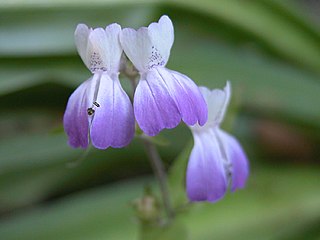
Collinsia multicolor is a species of flowering plant in the plantain family, known by the common names San Francisco blue eyed Mary and San Francisco collinsia. It is endemic to the San Francisco Bay Area, where it is known from San Francisco to Santa Cruz. As of 2008 there are 22 known occurrences. Populations south of Santa Cruz have been extirpated.

Porterella is a monotypic genus of flowering plants in the bellflower family containing the single species Porterella carnosula, which is known by the common name fleshy porterella, or simply porterella.

Psorothamnus schottii is a species of flowering plant in the legume family known by the common name Schott's dalea. It is native to the Sonoran Deserts of northern Mexico and adjacent sections of Arizona and the Colorado Desert in California.

Silene scouleri is a species of flowering plant in the family Caryophyllaceae known by the common names simple campion and Scouler's catchfly.

Iris korolkowii is a plant species in the genus Iris. It is also in the subgenus Iris and in the section Regelia. It is a rhizomatous perennial, from the mountains of Tien Shan, Pamir and Altai, in Afghanistan and Turkestan. It is commonly known as the Redvein Iris. It has long, sword-shaped grey-green leaves, slender stem, and 2 to 3 white, cream, pale green or light purple flowers which are veined with maroon, chocolate brown or dark purple. It is cultivated as an ornamental plant in temperate regions.
